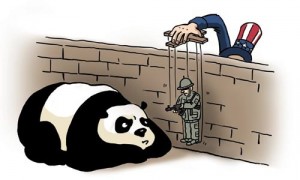CNO’s 30-Year Shipbuilding Strategy Reflects Lessons of his Favorite Book

Armchair Admirals and defense analysts alike lit up the blogosphere when President Obama first announced the strategic “Pivot” from Mid-East counterinsurgency operations to the Pacific, with visions of Surface Action Groups, Carrier Battle Groups, and Amphibious Task Forces the like of which haven’t been seen since former Secretary of the Navy John Lehman’s 600 Ship Navy. Alas, the CNO’s vision of that Pivot leaves many feeling like the victims of a Jedi Mind Trick: “This isn’t the Fleet you’re looking for.”
Afloat Forward Staging Bases (AFSBs), Joint High Speed Vessels (JHSVs), Mobile Logistics Platforms (MLPs), and Littoral Combat Ships (LCS) will never be mistaken for surface combatants; however, they represent the product of a refined understanding of what wars we are likely to fight in the future, and a “sabermetric analysis” of what it takes to win the peace in the Pacific—presence, lift, and command and control (C2). While facing significant fiscal constraint, by focusing acquisitions on affordable platforms capable of persistent presence in uncontested waters and afloat forward basing of expeditionary / special operations forces, Admiral Greenert is on the cusp of successfully employing strategic Moneyball in his 30-year shipbuilding plan.
According to National Security Advisor Tom Donilon, the purpose of the Pivot is:
“…strengthening alliances; deepening partnerships with emerging powers; building a stable, productive, and constructive relationship with China; empowering regional institutions; and helping to build a regional economic architecture that can sustain shared prosperity.”
Key to achieving these strategic aims is regional stability—a stability that can only be maintained with the confidence of regional power brokers that the status quo is acceptable and not threatened. The U.S. supports freedom of navigation and defense of its allies against rogue actors such as the Democratic People’s Republic of Korea (DPRK) through deployment of conventional naval forces such as Ballistic Missile Defense (BMD)-cruisers and destroyers. However, these ships do not provide an optimal platform for two of our largest mission sets in strengthening alliances and partnerships: Theater Security Cooperation and Humanitarian Assistance / Disaster Response (HA/DR). Relatively low-cost, an ability to embark disparate and substantive payloads, and a capability to access littoral waters make JHSV, MLP, and LCS the optimal platforms for these missions.
In his recent book, Invisible Armies, Max Boot notes that the most prolific type of war throughout history is the insurgency. Indeed, the last true state vs state war took place over the course of a few weeks in 2008 between Georgia and the Russian Federation, while formal insurgencies continue on every continent save Antarctica and Australia. Since 1945 and the information/media revolutions, insurgent victory rates have increased from 29% to 40% (with caveats). As the ability to access and broadcast information increases and fractures to different mediums, Boot hypothesizes that insurgent success rates will continue to grow; with it, insurgencies will proliferate. The United States has spent the past decade refining our doctrine, organization, training, materiel, leadership, personnel, and facilities (DOTMLPF) to successfully implement counterinsurgency. Having sacrificed this capability and capacity many times in the past to refocus on building large, conventional forces to engage in rare conventional combat, the Department of Defense has the chance to make a historic deviation and retain some of that urgently needed competence. Bottom line: insurgencies aren’t going away anytime soon, and neither should naval ability to support counterinsurgency operations.
There exists a myth of “credible presence” in some corners of naval strategy. This myth devalues the “sabermetrics” of presence, lift, and C2 for more traditional metrics of large-caliber guns, vertical launch cells, and radar dB. Purveyors of the myth believe that absent a Mahanian armada capable of intimidating the People’s Liberation Army (Navy) to never leave their inshore territorial waters, our presence operations aren’t ultimately successful. The myth operates under the false portrayal of the People’s Republic of China as a monolith, the same fallacy with regards some of our recent adversaries—Ba’athists, Islamists, and Communists. The PRC and the U.S. conduct over $500 billion in trade annually, much of that through PLA and PLA(N) companies that would stand to lose their financial backing should a shooting war break out between the U.S. and PRC—an undesirable outcome despite the testy rhetoric of select PLA generals and colonels. The question is not how to win a war with the PRC—I am confident that we can do that, albeit painfully. The question that should drive our acquisitions in the Pivot is “how do we win the peace?”
The capability and capacity of JHSVs, MLPs, and LCSs to successfully conduct afloat forward staging and presence operations has been demonstrated by their respective ship class predecessors both operationally (Philippines, Africa Partnership Station, Southern Partnership Station, Somalia) and in exercises (Bold Alligator, Cobra Cold). By focusing acquisitions on these platforms, we stand a greater chance of building on both our presence and afloat forward-staging capability/capacity. While the Air-Sea Battle and its high-end carriers, cruisers, destroyers, and amphibious task forces is an essential strategy to deter armed aggression by China, the CNO is playing Moneyball to win the peace at a bargain price.
Nicolas di Leonardo is a member of the Expeditionary Warfare Division on the OPNAV Staff and a graduate student of the U.S. Naval War College. The views expressed by this author are his alone and do not necessarily reflect the official positions of the Expeditionary Warfare Division, the Naval War College, or the United States Navy






